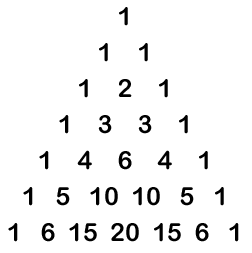Symmetry is a way of providing a shortcut when r is a large number. An example could be choosing 11 people (r) from 15 (n) - you can either name the 11 you've selected or the 4 you've rejected. So every choice you have of r objects included in a selection from n distinct objects corresponds to a choice of (n - r) objects which are excluded. So basically, nCr = nCn - r. You can also see the list of values of nCr for any particular value of n is unchanged by being reversed. E.g. when n = 6, the list is still 1, 6, 15, 20, 15, 6, 1.
Addition n + 1Cr + 1 = nCr + nCr + 1
For this we need to have a look at Pascal's triangle:

If we look at the 15 on the 6th row, we can see that the two numbers above it add together to give the value, 10 + 5. We know that 10 and 5 are both nCr themselves, and can be called 5C1 and 5C2. So, we can say that 5C1 + 5C2 = 6C2 (the nCr value of 15. We could use this method to build up a table of nCr values without calculating much. Lets give an example that X is either included or not. If it's included, you have to choose r more objects from the other n objects. This can be done in nCr ways. If it's not included, you have to choose all r + 1 objects from another n objects - nCr + 1 ways. These two cases cover all possibilities so n + 1Cr + 1 = nCr + nCr + 1.



